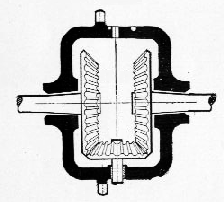 | 
The differential from an early motor-car. |
The automobile differential is very similar to the elementary rotary differential. The main difference is that the blue gear has been moved outside the green. But the same equation holds between the three rotations: purple gear (a), green gear (b) and blue gear (c) : c = (a+b)/2 , or a+b=2c. A housing is built on the blue gear to hold the pinion or pinions. The diagram shows how power is transmitted by bevel gearing from the driveshaft to the blue gear (called crown gear in this context).

Another differential from an early motor-car, with a view of the inside. This car was chain-driven, and sprockets on the housing (of which two are visible) take tke place of the crown gear. The images of early differentials are taken from "The Automobile Instructor" by Clyde H. Pratt, Shrewsbury Publishing Co., Chicago 1917. |
In an automobile, the differential connects the driveshaft to the axles. Its role is to balance the flow of power from the engine to the wheels. The equation a+b=2c means that the wheels share between them the rotation coming from the engine. When the car is traveling in a straight line, the wheels roll the same amount: a=b, and both are equal to c. When the car goes around a curve, the differential allows the outside wheel to travel farther, and the inside wheel to travel less far. Only the sum of their rotations is steady at 2c. If the engine is locked and the wheels are free to turn, turning one wheel will cause the other to rotate in the opposite directon (a+b=0). On the other hand if one wheel is free to turn (e.g. in snow or mud) and the engine is running, the other wheel will not turn at all: a=2c, b=0. This is frequently experienced.









